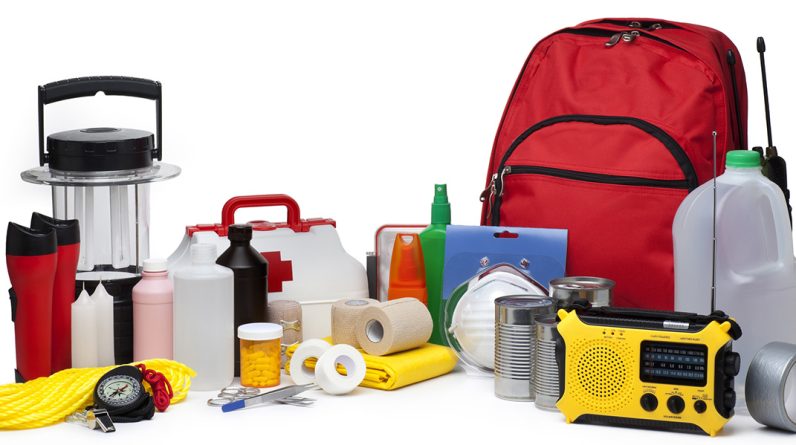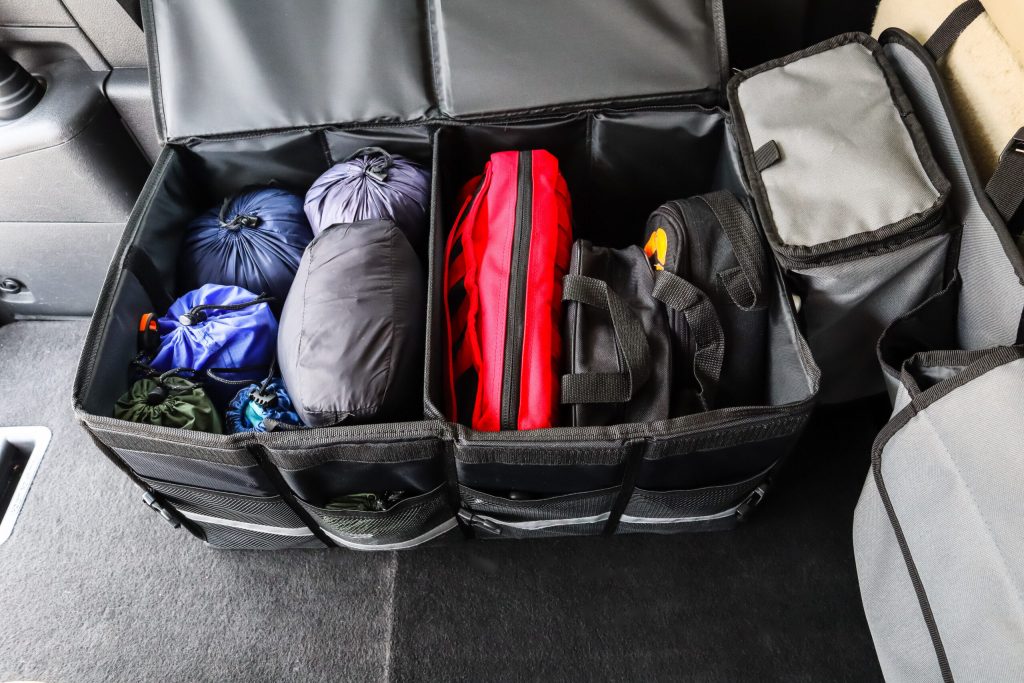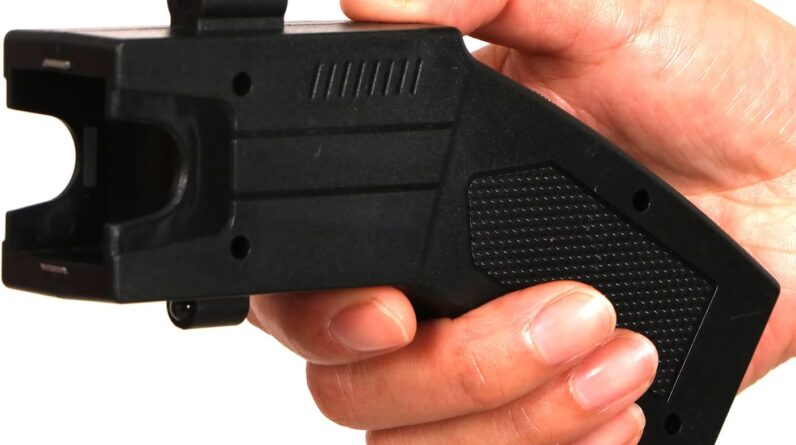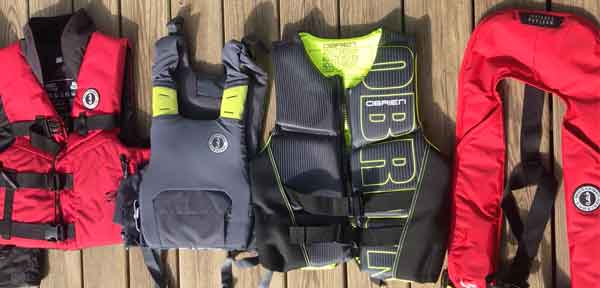
In this comprehensive guide, you will learn everything you need to know about storing and maintaining your emergency kit. Whether you are a seasoned preparedness enthusiast or a beginner looking to be more proactive, this article will provide you with key tips and strategies to ensure that your emergency kit is always ready for any unforeseen circumstances that may arise. From organizing and labeling your supplies to regularly checking and replacing expired items, this guide will equip you with the knowledge and confidence to be well-prepared for any emergency situation. So, let’s dive in and discover the ultimate guide to properly storing and maintaining your emergency kit!

This image is property of practicalperfectionut.com.
Choosing the Right Storage Container
Considerations for selecting a storage container
When it comes to storing your emergency supplies, choosing the right storage container is crucial. Consider the size and capacity of the container, ensuring that it can hold all your essential items. Look for a sturdy and durable container that can withstand various environmental conditions. Furthermore, opt for a container that is easy to transport, as you may need to take it with you in the event of an emergency.
Types of storage containers
There are various types of storage containers available, each with their own unique features and advantages. Plastic bins or totes are popular choices due to their durability and affordability. They are also stackable, making them ideal for organizing and maximizing storage space. Another option is a waterproof and airtight container, which provides extra protection against water damage and keeps your supplies safe from moisture and pests. Alternatively, you may also consider a backpack-style emergency kit, which offers portability and convenience.
Features to look for in a storage container
When selecting a storage container, keep an eye out for certain key features. Look for containers with secure latches or locks to ensure that your supplies are safely stored and won’t spill out during transportation. Additionally, consider containers with built-in handles or wheels for easy carrying or rolling. If you anticipate the need for quick access to your supplies, choose a container with a removable lid or one that allows easy access to the contents. Lastly, prioritize containers made from high-quality materials that are resistant to impact, moisture, and UV rays, as this will help to ensure the longevity of your emergency kit.
Ideal Storage Conditions
Temperature and humidity
One of the most important factors in properly storing your emergency kit is maintaining the right temperature and humidity levels. Extreme temperatures can deteriorate the quality and efficacy of certain items such as food, medications, and batteries. It is recommended to store your emergency kit in a cool, dry place, preferably between 40°F (4°C) and 70°F (21°C). High humidity can introduce moisture to your supplies, resulting in mold growth or equipment malfunction. Avoid basements, attics, or areas prone to flooding as they typically have high humidity levels.
Protection from sunlight
Sunlight can cause degradation and discoloration of many items in your emergency kit, such as medications, food, and certain types of batteries. To prevent this, store your kit in a dark or low-light area. If sunlight exposure cannot be completely avoided, consider using opaque containers or covering the kit with a light-resistant material. Keeping your emergency supplies away from direct sunlight will help maintain their quality and extend their shelf life.
Avoiding extreme conditions
Extreme conditions, such as freezing temperatures or excessive heat, can significantly impact the effectiveness and integrity of your emergency supplies. Freezing temperatures can cause water bottles to burst, render certain medications ineffective, and damage electronic devices and batteries. On the other hand, excessive heat can accelerate the expiration of food, degrade medications, and compromise the functionality of electronic equipment. Always store your emergency kit in a location where it is protected from extreme conditions to ensure the reliability and usability of your supplies.

This image is property of www.ready.gov.
Organizing Your Emergency Supplies
Categorizing your items
To effectively organize your emergency supplies, consider categorizing them based on their function or intended use. For example, group together food items, water bottles, first-aid supplies, flashlights, batteries, and other relevant categories. This allows for easier and quicker retrieval of items during an emergency situation. By categorizing your supplies, you can easily identify any items that may be missing or need replenishing.
Using labels and color-coding
To further enhance the organization of your emergency kit, utilize labels and color-coding. Label your storage containers or shelves with clear, concise descriptions of their contents. This serves as a helpful visual guide, especially during times of stress or urgency. Color-coding can also aid in identifying different categories of supplies at a glance. For instance, green labels or markings can denote first-aid supplies, red can represent food items, and blue can indicate water storage. Consistently using labels and color-coding will greatly simplify the process of locating and accessing your emergency supplies.
Creating a checklist
Maintaining an inventory checklist is essential for tracking and managing your emergency supplies. List down all the items in your kit, including their quantities and expiration dates if applicable. Regularly review and update the checklist to ensure that your supplies are complete and up to date. This serves as a helpful reference when restocking or replenishing your emergency kit. Additionally, consider including a section for important contact numbers, emergency protocols, and instructions for using specific items. Having a comprehensive checklist will contribute to the efficiency and effectiveness of your emergency preparedness efforts.
Maintaining Freshness of Food and Water
Rotating food and water supplies
Food and water are vital components of any emergency kit, and it’s important to regularly rotate these supplies to maintain their freshness and suitability for consumption. Most non-perishable food items have a shelf life, so be sure to check the expiration dates on a regular basis. Create a system where you consume the oldest food items first and replace them with fresh ones. Similarly, water should be replaced every six months to ensure its quality and safety. Proper rotation of food and water supplies will guarantee that you have access to nourishment during an emergency situation.
Checking expiration dates
When it comes to storing food in your emergency kit, always be mindful of expiration dates. Regularly check the labels on your food items and discard any that have exceeded their expiration date. Consuming expired food can lead to foodborne illnesses, which is the last thing you want during an emergency situation. By diligently monitoring expiration dates, you ensure that your emergency food supplies are safe and effective when you need them the most.
Replacing water every six months
Water is essential for survival, and you should always have a sufficient supply in your emergency kit. However, water can become stagnant and potentially contaminated if left stagnant for extended periods. To prevent this, replace the water in your emergency kit every six months. Use clean, food-grade containers and seal them tightly to prevent any contamination. Maintaining a regular schedule for replacing your water supply will provide you with clean and safe drinking water in case of an emergency.

This image is property of taskandpurpose.com.
Preserving Medications
Storing medications in a cool, dry place
Properly storing medications is crucial to maintaining their effectiveness and safety. Most medications are sensitive to temperature and humidity, so it’s essential to store them in a cool, dry place. Avoid storing medications in the bathroom, as the humidity from showers can impact their potency. Instead, choose a designated area in your home where the temperature remains relatively stable, such as a drawer or a cabinet. By storing medications properly, you ensure that they retain their therapeutic value when you need them.
Monitoring expiration dates
Just like food items, medications have expiration dates too. It’s important to regularly check the expiration dates on your medications and dispose of any that have expired. Expired medications may have reduced efficacy or even pose health risks if consumed. To stay ahead of any potential issues, make it a habit to check your medications at least once a year and replace any that are nearing their expiration date.
Using appropriate containers and packaging
When storing medications in your emergency kit, choose containers and packaging that are appropriate for the specific medication. Some medications may require extra protection from light, moisture, or air, so be sure to utilize the original packaging if possible. If the original packaging is not available, consider using airtight and light-resistant containers, such as pill organizers or medication bottles. Proper packaging plays a vital role in preserving the integrity and stability of your medications.
Regularly Inspecting and Testing Equipment
Checking batteries in flashlights and radios
Flashlights and radios are essential tools in any emergency kit, but they require functional batteries to be effective. Regularly inspect the batteries in your flashlights and radios to ensure they are working properly. Consider using long-lasting lithium batteries, as they have a longer shelf life compared to alkaline batteries. It’s also wise to keep spare batteries in your emergency kit, as a backup in case of battery failure. Regularly testing the functionality of your flashlights and radios will help guarantee their reliability during an emergency.
Testing portable chargers and power banks
In today’s digital age, having a functioning portable charger or power bank is crucial during emergencies. These devices keep your smartphones, tablets, and other electronic devices powered up and connected to the outside world. Regularly test your portable chargers and power banks to ensure they are holding a charge and delivering power as expected. If you notice any issues or decreased performance, replace them with new ones to maintain a reliable power source in your emergency kit.
Inspecting first-aid supplies
First-aid supplies are critical for addressing injuries and providing immediate medical attention during emergencies. Regularly inspect your first-aid supplies to ensure that they are complete, sterile, and not expired. Check the contents of your first-aid kit and replace any used or expired items. Additionally, make note of any specific items that may need regular replenishment, such as adhesive bandages or antiseptic ointments. By regularly inspecting and replenishing your first-aid supplies, you can ensure their effectiveness and readiness when faced with an emergency situation.

This image is property of www.cdph.ca.gov.
Ensuring Accessibility in Times of Emergency
Choosing a strategic location for the kit
When it comes to the accessibility of your emergency kit, choosing the right location is key. Select a location that is easily accessible to all family members and minimizes the risk of damage or obstruction during an emergency. Ideally, the kit should be stored on the ground floor or in an easily reachable area. Avoid placing it in areas prone to flooding or where it can become inaccessible due to collapsed structures. By strategically positioning your emergency kit, you can ensure its accessibility when every second counts.
Informing family members or close contacts
It is important to inform your family members or close contacts about the location of your emergency kit. Make sure they are aware of the contents of the kit and how to access it. Discuss the importance of the kit and its role in emergency preparedness. By sharing this information, you ensure that everyone in your household is on the same page and can act swiftly during an emergency.
Preparing a portable version of the kit
In addition to your main emergency kit, it is beneficial to prepare a portable version that you can grab and take with you in case of an evacuation. This portable kit should contain essential items such as a flashlight, spare batteries, a small first-aid kit, food bars, water packets, and any important documents or medications. Having a portable emergency kit will provide you with peace of mind, knowing that you have the necessary supplies readily available, even if you need to evacuate quickly.
Properly Disposing of Expired or Damaged Items
Identifying signs of damage or spoilage
Regularly inspect your emergency supplies for any signs of damage or spoilage. Look for leaking water bottles, dented or bulging food cans, discolored medications, or any visible signs of mold or pests. It is important to promptly remove and replace any items that show signs of damage or spoilage. Consuming spoiled or damaged items can lead to health issues and defeat the purpose of having an emergency kit.
Following disposal guidelines for hazardous materials
Certain items in your emergency kit, such as expired medications or expired fire extinguishers, may be considered hazardous waste. It is important to follow proper disposal guidelines for these hazardous materials. Contact your local waste management facility or consult with your municipality to understand the specific requirements and recommendations for disposing of hazardous materials in your area. Acting in accordance with these guidelines ensures the safe and responsible disposal of expired or damaged items.
Taking note of expiration dates and replacing items
Expiration dates play a crucial role in maintaining the reliability and effectiveness of your emergency supplies. Make a habit of regularly checking the expiration dates on all items in your emergency kit, including food, medications, and batteries. Create a schedule or reminder system that prompts you to replace items before they expire. By staying vigilant and promptly replacing expired items, you ensure that your emergency kit is always stocked with fresh and reliable supplies.

This image is property of miro.medium.com.
Maintaining Emergency Kit Documentation
Creating an inventory list
Creating an inventory list is an essential part of maintaining your emergency kit. It acts as a reference for tracking the contents of your kit, including quantities, expiration dates, and additional notes. Update your inventory list regularly and keep a digital or printed copy in a safe and easily accessible location. Having an inventory list allows you to quickly identify any missing items or items that need replacing, ensuring that your emergency kit remains well-stocked and up to date.
Keeping important documents
In addition to supplies, it is crucial to include important documents in your emergency kit. Make sure to keep copies of identification documents, insurance policies, medical records, and any other vital documents that may be necessary during an emergency, such as contact information for emergency services or important phone numbers. Store these documents in a waterproof and fireproof container or consider keeping digital copies on a portable storage device or cloud storage. By having important documents readily available, you can navigate through emergency situations with ease and efficiency.
Regularly updating contact information
Contact information can change over time, so it’s important to regularly update your emergency kit with the most current contact details. Update the list of emergency contacts, including family members, close friends, healthcare providers, and local emergency services. Additionally, consider including contact information for out-of-state or out-of-area contacts who can serve as a point of communication during large-scale emergencies that may disrupt local services. By regularly updating your contact information, you ensure that you can easily reach out for assistance or support when needed.
Revisiting and Reevaluating Your Emergency Kit
Conducting regular check-ups
Emergency preparedness is an ongoing process, and it is crucial to conduct regular check-ups of your emergency kit. Set aside time at least once a year to thoroughly inspect and evaluate your emergency supplies. Check for any expired items, damaged equipment, or missing supplies. Consider seeking expert advice or consulting with emergency preparedness resources to stay updated on the latest recommendations and best practices. By conducting regular check-ups, you ensure that your emergency kit remains robust and reliable.
Updating supplies according to changing needs
As time goes on, your emergency needs may change. New family members may join or existing family members may have different dietary or medical requirements. Regularly assess and update your emergency kit to accommodate these changing needs. Add additional supplies or adjust quantities as necessary. It is also important to consider any specific risks or hazards in your area and tailor your emergency supplies accordingly. By staying proactive and adaptive, you can ensure that your emergency kit is always well-suited to your unique needs and circumstances.
Seeking expert advice and recommendations
When it comes to emergency preparedness, it can be beneficial to seek expert advice and recommendations. Emergency management professionals or organizations, local authorities, and reputable online resources can provide valuable insights and guidance. Stay informed about the latest developments in emergency preparedness, recommended supply lists, and best practices. By incorporating expert advice into your emergency preparedness efforts, you can enhance the effectiveness and reliability of your emergency kit.
In conclusion, properly storing and maintaining your emergency kit is essential for ensuring your readiness in times of crisis. By choosing the right storage container, maintaining ideal storage conditions, organizing your supplies, preserving the freshness of food and water, properly storing medications, regularly inspecting and testing equipment, ensuring accessibility, disposing of expired or damaged items correctly, maintaining documentation, and regularly reevaluating your emergency kit, you can stay well-prepared and confident in your ability to handle any emergency situation that may arise. Stay safe, stay prepared!



